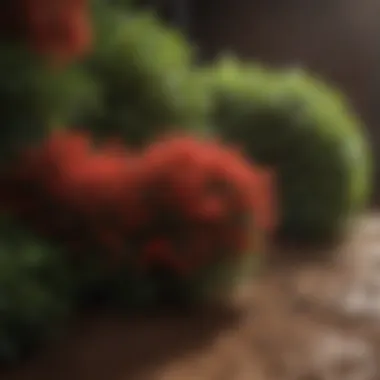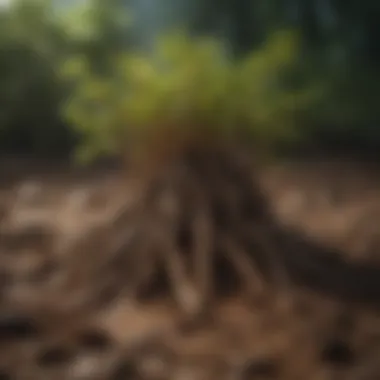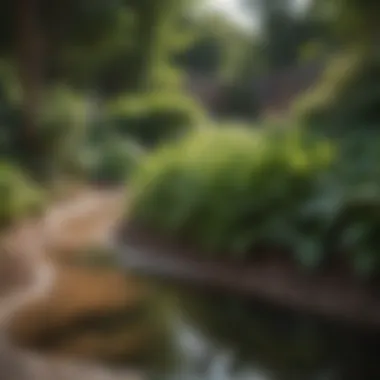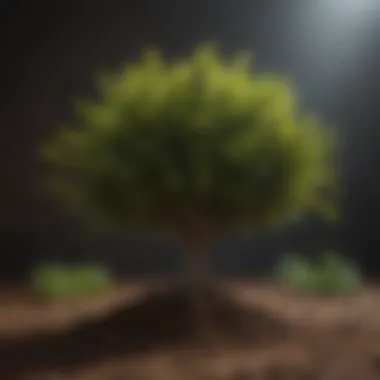Top Shrubs for Thriving in Wet Clay Soil


Intro
Wet clay soil presents unique challenges for gardeners and landscapers. It retains moisture and can become heavy, limiting the types of plants that thrive. However, some shrubs are well-suited for these conditions. This guide aims to provide insights into the selection and care of bushes that flourish in wet clay soil. Emphasis will be on their growth traits and environmental adaptability.
Design Inspiration
When considering landscaping with shrubs suitable for wet clay soil, it’s useful to incorporate contemporary design elements.
Some trends that enhance outdoor aesthetics include:
- Native Plant Integrations: Utilizing local flora helps in sustainability and supports local ecosystems.
- Edible Landscapes: This trend focuses on incorporating food-producing plants into garden designs.
- Naturalistic Styles: These designs mimic natural landscapes, using plants that blend seamlessly with the surrounding terrain.
Color plays a significant role in landscape design. When planning the layout, consider:
- Complementary Colors: Choose shrubs that offer color contrast with your home or surrounding landscape.
- Seasonal Palettes: Selecting shrubs that bear different hues across seasons brings year-round interest.
Gardening Techniques
Plant Selection and Care
Picking the right shrubs is crucial. Consider species like red twig dogwood, willow, and corkscrew willow, known for their resilience in wet conditions. When planting, ensure proper spacing to enhance air circulation. Additionally, mulching can help regulate soil moisture and temperature.
To maintain health, regular check-ups are essential. Watch for pests and diseases specific to wet environments; early identification is key to successful management.
Outdoor Gardening
Wet clay soil requires specific strategic planning. When planting outdoors:
- Water Management: Ensure that excess water can drain effectively, utilizing raised beds if required.
- Companion Planting: Some shrubs work better alongside others, enhancing growth and reducing pests.
Homeowners can create functional and visually appealing spaces by understanding their soil type and selecting appropriate shrubs.
"The right choice of shrubs transforms wet clay soil from a challenge into an asset in any landscape."
Leveraging knowledge of plant characteristics will empower gardeners to optimize their wet clay areas without sacrificing beauty or plant health.
Foreword to Wet Clay Soil
Gardening in wet clay soil presents both challenges and unique opportunities. This section is aimed to lay the groundwork for understanding wet clay soil's characteristics and the implications for planting shrubs. Wet clay can be an impediment to many plants' growth due to poor drainage and high moisture levels. However, acknowledging these factors allows for informed choices, leading to successful gardening.
Understanding Wet Clay Soil Characteristics
Wet clay soil is defined by its small particle size and compact structure, which results in a dense and heavy texture. This makes it retain water poorly and restricts root growth. The soil's composition plays a significant role in how efficiently it holds moisture, nutrients, and even air, which plants need to thrive. When saturated, wet clay can become even more compacted, further hindering the root systems of many plants.
Key characteristics of wet clay soil include:
- High moisture retention: Retains water longer than other soil types.
- Poor drainage: Easily becomes waterlogged, leading to root rot in sensitive plants.
- Nutrient availability: While it can hold nutrients, the availability fluctuates with moisture levels.
- Temperature regulation: Tends to heat slowly in spring and cools down slowly in autumn.
Understanding these traits is crucial for selecting appropriate plant species that can thrive in such conditions.
Challenges of Gardening in Wet Clay
Gardening in wet clay poses several challenges that must be navigated carefully. First, the water retention of clay can create a soggy environment that is unsuitable for many plants. This is especially true during heavy rains or overwatering periods. The consequence of prolonged saturation is the risk of diseases like root rot, which can devastate plant populations.
Another challenge arises with soil aeration. The dense nature of clay often restricts the flow of oxygen to roots, which can stunt their growth or lead to poor development. Moreover, managing plant diversity in wet clay soil can also be tricky. While certain shrubs flourish, others may require specific amendments to soil composition or drainage improvements.
To summarize, the challenges of wet clay soil can be mitigated with the right understanding, but they do necessitate careful consideration in plant selection and gardening practices. Recognizing these issues upfront ensures that gardeners can plan accordingly, ultimately leading to successful and vibrant landscapes.
Importance of Selecting the Right Plants
Choosing the right plants for an area with wet clay soil is crucial. This journey begins with understanding how the plants will adapt to challenging conditions. Wet clay soil can be dense, with poor drainage, which makes it differ from other types of soil. Selecting suitable bushes not only ensures healthier growth but also enhances the landscape.


An informed choice leads to several benefits.
- Reduced Maintenance: The right bushes are more likely to thrive with little intervention. Native species, for instance, often require less care as they are acclimated to local climates and soil types.
- Aesthetic Appeal: Well-chosen plants can bring visual appeal to an area. This can create a pleasing contrast in colors and textures that capture attention.
- Ecosystem Support: Plants can contribute to a healthy ecosystem. By choosing native species, you support local wildlife, which can create a balanced environment.
"Selecting the right plants for wet clay soil is not just about looks; it's about creating a functional and sustainable landscape."
The initial considerations should extend beyond mere vegetation. The long-term potential and effects of these choices are essential. Hence, it is vital to integrate thoughtful planning into garden design that accommodates the natural characteristics of wet clay soil.
Benefits of Native Species
Native species are exceptionally well-suited for wet clay soil. Their root systems have adapted to local moisture levels and can withstand flooding better than many non-natives. Additionally, they play an essential role in local ecosystems.
- Adaptation: Native bushes have resilient characteristics, allowing them to flourish with little help.
- Diversity: These plants attract various pollinators and beneficial insects, thus enhancing biodiversity in your garden.
Integrating native species can simplify management and increase the likelihood of a thriving garden.
Long-Term Sustainability Considerations
The sustainability of a landscape heavily relies on the plants selected. Using shrubs that naturally thrive in wet clay means less intervention from fertilizers and excessive watering. This approach can lead to healthier soil over time.
- Soil Health: As roots anchor into the clay, they break it apart, aiding drainage and nutrient absorption for future plantings.
- Pest Resistance: Native plants tend to resist local pests and diseases better than imported varieties.
Recommended Bushes for Wet Clay Soil
Selecting the right bushes for wet clay soil is crucial in ensuring a healthy and aesthetically pleasing garden. Many plants struggle in compacted and saturated conditions, but certain species thrive under these circumstances. Recommended bushes not only survive but often enhance the environment, offering numerous benefits. These include improved soil erosion control, wildlife habitat, and even stormwater management. An understanding of their adaptability and maintenance needs will help homeowners and gardeners make informed choices.
Willow Shrub Varieties
Willow shrubs are among the most effective choices for wet clay soil. They are well-known for their ability to tolerate moisture and thrive in less-than-ideal conditions. Their adaptable nature makes them suitable for various landscapes, from residential gardens to commercial setups.
Salix integra - Dappled Willow
Salix integra, commonly known as Dappled Willow, is a striking choice. Its leaves have a unique variegated pattern that adds visual interest to a garden. This shrub is particularly valued for its vigorous growth and ability to tolerate both wet and dry spells. Dappled Willow prefers partial shade but can flourish in full sun, making it versatile for many types of borders and beds.
The key characteristic of Dappled Willow is its colorful foliage that shifts with the seasons. In spring, the leaves emerge with a blend of green and creamy white. The summer brings a lush green, while in the fall, you will see warm golden tones. This shrub provides excellent seasonal interest, which is often sought in landscape design.
However, potential disadvantages include its need for regular pruning to maintain shape and encourage new growth. This upkeep can be time-consuming but ultimately aids in maintaining the shrub's attractiveness.
Salix purpurea - Purple Willow
Salix purpurea, or Purple Willow, is another excellent option for wet clay soils. This shrub stands out due to its dark purple stems, which are particularly pronounced in winter when the leaves have fallen. This striking visual contrast makes it a popular choice for year-round interest.
The key characteristic of Purple Willow is its rapid growth rate. This allows it to establish quickly in a new environment, making it well-suited for gardens that require immediate coverage or erosion control. Its root systems can aid in stabilizing the soil, especially near waterways or sloped terrain.
One unique feature of Purple Willow is its ability to be easily pruned into various shapes, thus providing versatility in design. However, this shrub can become leggy if not maintained properly, necessitating regular trimming to encourage denser growth.
Buttonbush (Cephalanthus occidentalis)
Buttonbush, scientifically known as Cephalanthus occidentalis, is a native wetland shrub suitable for clay soils. This plant is recognized for its round, globular flower clusters that bloom in summer, attracting a variety of pollinators such as bees and butterflies.
The structure of Buttonbush makes it ideal for wet areas. Its extensive root system helps in soil stabilization, a critical factor in preventing erosion in marshy conditions. The visual interest created by its unique flowers further enhances its appeal in the landscape.
However, Buttonbush may require careful location selection, as it can spread aggressively under optimal conditions. Homeowners should therefore monitor its growth to maintain desirable landscape aesthetics.
Ninebark (Physocarpus opulifolius)
Ninebark, or Physocarpus opulifolius, brings a tough yet appealing choice to wet clay soil gardens. It features peeling bark that adds texture and visual interest. In addition to its aesthetic appeal, this shrub is also known for its hardiness and adaptability.
Ninebark produces white to pinkish flowers in late spring, followed by ornamental seed capsules. The key characteristic of this plant is its ability to thrive in poor soil conditions, including clay. This resilience, combined with its natural beauty, makes it a smart choice for various landscaping projects. Additionally, its suckering habit helps to fill space effectively.
Nonetheless, those interested in Ninebark should be aware of its tendency to attract certain pests. By recognizing these issues early, gardeners can take necessary preventive measures to protect this attractive shrub.


Red Osier Dogwood (Cornus sericea)
Red Osier Dogwood, or Cornus sericea, is celebrated for its vivid red stems, particularly noticeable in winter. This shrub excels in wet environments and can withstand periodic flooding. It plays a critical role in enhancing soil stability due to its extensive root system.
The key characteristic of Red Osier Dogwood is its adaptability. This shrub can thrive in a range of conditions, from full sun to partial shade. Additionally, it offers benefits for local wildlife, functioning as a food source and habitat for various species.
However, its aggressive growth can be a concern. Gardeners may need to manage its spread actively to maintain their desired landscape design. Regular maintenance and shaping are key practices for optimal growth.
Elderberry (Sambucus canadensis)
Elderberry, with the scientific name Sambucus canadensis, is another highly beneficial choice for wet clay soil. It is recognized for its extensive clusters of white flowers, which later produce dark berries. These berries are edible and often used in jams and syrups, providing added value to any garden.
The key characteristic of Elderberry lies in its role as a wildlife attractor. It serves as a food source for birds and beneficial insects, enriching the ecosystem within a garden space. Elderberry is also tolerant of wet conditions and can help manage water runoff effectively.
While it offers many benefits, Elderberry needs room to spread. Homeowners should plan for its growth and consider location to avoid overcrowding in the garden.
Selecting the right bushes for wet clay soil can transform challenging landscapes into flourishing, dynamic environments. Knowing the characteristics of each plant allows for a tailored approach to gardening that considers both aesthetic and functional needs.
Planting and Maintenance Tips
Planting and maintaining bushes in wet clay soil demands special consideration. This section addresses practical strategies to ensure your plants thrive. Understanding the plant's needs and adapting to the unique characteristics of wet clay soil are essential. Proper techniques not only enhance growth but also improve the overall landscape aesthetics.
Soil Preparation Techniques
Before planting, it is crucial to prepare the soil effectively. Wet clay soil can compact easily, limiting root growth. A well-prepared soil enhances drainage and aeration. To begin, consider these steps:
- Test the Soil: Conduct a soil test to understand its pH and nutrient levels. This determines any necessary amendments.
- Amend the Soil: Adding organic matter like compost or well-rotted manure can improve soil structure. This helps reduce compaction and enhances moisture retention.
- Tilling: Light tilling may be beneficial to aerate the soil. However, avoid excessive tilling as it may create a dense layer beneath the surface.
- Create Raised Beds: Where appropriate, raised beds can help improve drainage in consistently wet areas. They offer a more controlled environment for plant roots.
By following these steps, you prepare a nourishing environment for your shrubs, allowing them to establish strong roots.
Watering Practices for Wet Clay
Despite the name, "wet clay" soil conditions vary. Some areas might be consistently saturated while others may experience periods of dryness. Understanding how to water appropriately is important:
- Observe Conditions: Check moisture levels before watering. Often, wet clay retains moisture well, reducing the need for additional water.
- Water Sparingly: Over-watering can lead to root rot. Ensure that you only water when necessary, considering recent rainfall and moisture retention.
- Deep Watering: When watering is needed, focus on applying water deeply and slowly. This encourages roots to grow downwards, establishing a stronger connection to groundwater.
Using these practices leads to healthier bushes that can withstand varied wet soil conditions.
Pruning and Training Techniques
Pruning is essential for maintaining both the health and aesthetics of your bushes. This practice should be approached mindfully:
- Timing: Prune during the dormant season for most varieties. This timing minimizes stress on the plant and promotes healthy growth in the spring.
- Remove Dead or Diseased Wood: This prevents the spread of pests and encourages new growth. Inspect plants regularly for any signs of disease or damage.
- Shape the Bush: Consider the natural shape of the bush, and prune to enhance its form. This may include cutting back overgrown branches or removing inward-facing growth.
- Encourage Airflow: Proper pruning promotes airflow within the plant, which is crucial in wet conditions to prevent mold and mildew.
Using deliberate pruning techniques improves both the health and appearance of your shrubs in wet clay conditions.
Successful gardening in wet clay relies on the combination of appropriate planting techniques, adequate watering practices, and thoughtful maintenance strategies. Each step plays a crucial role in the overall success of your landscape.
Designing with Bushes in Wet Areas
Creating a landscape that includes bushes in wet areas requires careful consideration. Wet clay soil presents both opportunities and challenges. Selecting the correct shrubs can enhance the overall aesthetic while ensuring the plants thrive in their environment. The right design maximizes the beauty of the landscape while catering to the specific growth needs of each bush. Understanding how to effectively integrate these plants will lead to more successful gardening and landscape designs.
Creating Visual Interest
Bushes can be a key feature in adding dimension and texture to a garden. When planting in wet areas, it's essential to consider the height, shape, and foliage of different shrubs. For instance, low-growing shrubs can create a soft border along pathways. Taller varieties can act as a backdrop, framing your garden's focal points.
Here are several factors when creating visual interest:
- Layering height and texture can create depth.
- Seasonal changes in foliage color and bloom patterns keep the garden dynamic.
- Focal points, such as colorful berries or unique leaf shapes, draw the eye.
Combining different species can create a more inviting space. For example, integrating flowering bushes with evergreen species ensures year-round visual appeal. Using contrasting colors, such as a bright and dark leaf mix, can make specific areas pop visually.


Design is not just what it looks like and feels like. Design is how it works.
Combining Shrubs with Other Plant Types
Bushes should not stand alone in design. When planning a landscape in wet clay soil, it is beneficial to combine shrubs with other plant types. This approach enhances biodiversity and improves the ecological health of the area. For example, pairing taller bushes with perennial flowers or grasses can help balance height and softness.
Benefits of combining different plant types include:
- Nutrient cycling: Different plants have varying root structures, which can improve soil health.
- Habitat creation: A mixed environment supports a wider range of wildlife.
- Pest control: Certain plants can deter pests, benefiting neighboring shrubs.
When integrating bushes with flowers or trees, pay attention to their specific needs. Light, water, and soil preferences should align. Consideration of blooming times can provide ongoing color throughout the growing season. This not only ensures that there is always something to see, but also creates a habitat rich in diversity.
By thoughtfully designing with bushes in wet areas, one can cultivate a landscape that is not only beautiful but also resilient. The integration of varied plant life plays a significant role in achieving a balanced and sustainable ecosystem.
Common Pests and Diseases
Understanding common pests and diseases is crucial for anyone dealing with gardens, especially those with bushes planted in wet clay soil. These environments can be breeding grounds for various pests and fungal diseases, which can severely impact plant health. Identifying these issues early can make a significant difference in maintaining a healthy landscape.
Identifying Common Issues
When considering bushes for wet clay soil, gardeners must recognize the potential threats posed by pests and diseases. Common pests include aphids, which can sap the plant's vigor, damaging leaves and stems. Additionally, spider mites can thrive in stressed plants, leading to discoloration and webbing on foliage.
Fungal diseases, such as root rot and powdery mildew, also pose significant risks. Root rot occurs primarily in poorly draining soils, a common condition in wet clay. The signs include wilting leaves and stunted growth. Powdery mildew, on the other hand, can appear as a white powdery substance on leaves and stems, particularly during warm, humid conditions.
Homeowners should regularly inspect their plants for:
- Discoloration or wilting
- Webbing or sticky residues on leaves
- White, powdery spots on surfaces
- An unusual number of insects on or around the bushes
Integrated Pest Management Strategies
To effectively manage pests and diseases in wet clay environments, Integrated Pest Management (IPM) strategies are essential. IPM is a holistic approach that combines different management practices to minimize damage while reducing dependence on chemical controls.
- Cultural Controls: Adjusting planting practices helps create conditions that discourage pests. For example, ensuring good drainage can prevent water accumulation, reducing the risk of root rot.
- Biological Controls: Introducing beneficial insects such as ladybugs can naturally control aphid populations. Additionally, certain fungi can combat pest species.
- Chemical Controls: When necessary, select targeted pesticides that are less harmful to beneficial organisms. This ensures that you protect your bushes without significant environmental impact.
- Regular Monitoring and Maintenance: Gardeners need to inspect their plants regularly. This includes checking for symptoms of disease and cleaning debris where pests can breed.
- Companion Planting: Utilizing companion plants that deter pests can enhance the health of your bushes. For example, marigolds are known to repel nematodes.
Effective pest management ensures the long-term vitality of your landscaping efforts.
By implementing these strategies and remaining vigilant, gardeners can successfully navigate the challenges posed by common pests and diseases in wet clay soil. Maintaining bush health ultimately contributes to thriving landscapes.
Case Studies of Successful Landscapes
Case studies of successful landscapes offer practical insights into the implementation of theories presented in this guide. They illustrate how specific shrubs can thrive in wet clay soil and enhance the beauty and functionality of garden spaces. Analyzing these transformations helps homeowners and landscaping professionals understand the nuances of plant selection, placement, and maintenance, leading to better gardening practices in their own endeavors.
Residential Transformations
In residential landscapes, shrubs adapted to wet clay soil can entirely change the aesthetic and ecological value of a property. For instance, a homeowner in the Pacific Northwest transformed their problematic wetland area using a combination of Red Osier Dogwood and Buttonbush. The vibrant colors and unique forms of these shrubs not only provided visual interest but also attracted local wildlife, enhancing biodiversity. This project highlights how strategic plant choices can convert a challenging area into a vibrant ecosystem.
Another example is from a suburban property in the Midwest where Ninebark was utilized. Often chosen for its attractive peeling bark and flower clusters, Ninebark flourished in this moist environment. The resident reported a significant reduction in standing water and improved landscaping aesthetic, demonstrating the shrub's capability to manage waterlogged areas effectively. Maintaining such plants on a regular basis, including proper pruning, ensured they remained healthy and visually appealing throughout the seasons.
Commercial Landscaping Solutions
Commercial properties also benefit from integrating shrubs suitable for wet clay soil. A notable instance is a university campus that included Elderberry in their landscaping design. This plant, besides its beauty, serves the dual purpose of being an effective rain garden plant. The Elderberry hedges created a natural barrier while enhancing water absorption, preventing soil erosion during heavy rainfalls.
Additionally, a retail center in the southeastern United States adopted Grandiflora Willow as part of their landscape redesign. The flexible branches and striking foliage of the willow added a modern touch to the storefront. Furthermore, it considerably improved stormwater management around the facility, aligning with sustainable design practices.
These case studies reaffirm the importance of selecting appropriate plants for wet clay soil. Lessons from both residential and commercial landscapes emphasize not only the beauty of these shrubs but also their functional contributions to the environment and usability. Taking inspiration from these examples can guide future projects, allowing gardens and landscapes to flourish even in challenging conditions.
Culmination
In summarizing the various elements surrounding bushes suited for wet clay soil, it becomes clear that the importance of understanding these characteristics cannot be overstated. Homeowners and gardening enthusiasts stand to benefit greatly from well-informed decisions about plant selection. Choosing the right bushes can transform challenging wet clay landscapes into thriving and visually appealing gardens.
The article emphasizes the adaptability of specific shrub species, such as Buttonbush and Elderberry, which flourish in wet conditions. Their resilience not only enhances the aesthetics of a garden but also contributes to ecological balance by supporting local wildlife. Therefore, selecting native species can lead to long-term sustainability, making a positive impact on local environments.
Consideration of maintenance needs and planting strategies is equally vital. Consumers can optimize their gardening efforts with effective soil preparation and proper watering techniques. This will ultimately result in lush plant growth, promoting green spaces that thrive in moisture-rich settings.
Ultimately, the insights presented throughout advocate for a thoughtful approach to gardening in wet clay soil. This article serves as a resource for homeowners, landscapers, and garden aficionados. By selecting suitable shrub varieties, following prudent maintenance practices, and designing thoughtfully, one can overcome the challenges posed by wet clay soil.
"The right plants can transform even the most difficult of wet clay landscapes into thriving ecosystems."



